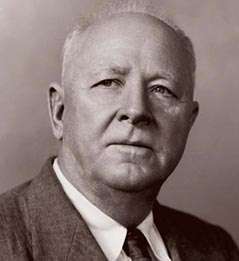Hugh Hammond Bennett

Hugh Hammond Bennett (April 15, 1881 – July 7, 1960) was a pioneer in the field of soil conservation in the United States of America. He founded and headed the Soil Conservation Service, a federal agency now referred to as the Natural Resources Conservation Service.
Bennett was born near Wadesboro in Anson County, North Carolina and graduated from the University of North Carolina in 1903. Immediately upon graduation, he became a soil surveyor, and conducted soil studies, both in the United States and in other countries, that eventually convinced him that soil erosion was a serious problem facing the planet.
Conservationism
By the 1920s, Bennett was actively writing about soil erosion for popular magazines and scientific journals, with works appearing in publications like Country Gentleman and Scientific Monthly.[1][2][3][4] He co-wrote a United States Department of Agriculture publication in 1928 titled Soil Erosion: A National Menace, which was regarded as his most influential work and garnered the attention of Representative James P. Buchanan of Texas.[5] Buchanan, who was a member of the United States House Committee on Appropriations, helped obtain funding in 1929 for soil erosion studies in the United States. Bennett was also instrumental in the formation of the Soil Conservation Society of America (now the Soil and Water Conservation Society).
Government service
When the Soil Erosion Service was established as part of the United States Department of the Interior in September 1933, Bennett became the director. He continued to speak out on soil conservation issues, especially through the Dust Bowl years, and eventually influenced the passage of the soil conservation act of April 27, 1935, which created the Soil Conservation Service at the USDA. He remained at the head of that organization until he retired in 1951.
Hammond hired Henry Howard Finnell to put his soil expertise to work:
Hugh Hammond Bennett, the head of the Soil Conservation Service, put Finnell in charge of Region Six, the hardest-hit area of the country; code name: "Operation Dustbowl." Finnell set up shop north of Dalhart. Areas where the soil was not suitable for cultivation were turned back to grassland. Thirteen other demonstration projects, manned by CCC and WPA workers, put Finnell’s moisture-conserving ideas to the test, with great success. By May of 1936, nearly 40,000 farmers had joined him, and 5.5 million acres were under new terraced and contour-listed cultivation. At the end of 1937, despite the persistent dust storms, the amount of dangerously eroded land had been reduced by more than half.[6]
Hammond's efforts changed the mindset of American farmers toward soil conservation, and as director of the Soil Conservation Service, he helped them learn new ways of cultivation that protected the soil and preserved fertility. The creation of the Soil Conservation Service and its inclusion in the United States Department of Agriculture also marked the US government’s acceptance and establishment of the interpretation of soils for soil and water conservation. As director of the SCS, Bennett launched a campaign for soil conservation toward educating the public and politicians by identifying areas in the Dust Bowl where the combination of geographic and agricultural systems caused the most serious erosion.[7]
Largely in response to Bennett's campaign for soil conservation, Representative James P. Buchanan of Texas attached an amendment to the 1930 appropriations bill authorizing the USDA to establish a series of soil erosion experiment stations. The Coon Creek Watershed Project, in southwestern Wisconsin, was the first of many watershed-based projects initiated to demonstrate soil conservation practices to farmers.[8] The locations for these stations were selected by Bennett, and involved teams of researchers establishing plots to measure erosion conditions under various types of crops, soils, rotations, and their responses to different agricultural managements practices and structures.[7]
Recognition
Bennett received many awards and honors for his work during his lifetime, including:
- President of the Association of American Geographers in 1943
- The Frances K. Hutchinson Award from the Garden Club of America in 1944
- The Cullum Geographical Medal by the American Geographical Society in 1948
- The Distinguished Service Medal by the USDA in 1947
- The Audubon Medal by the National Audubon Society in 1947
- A fellow of the American Society of Agronomy in 1947
In 2000, Bennett was named a charter inductee into the USDA Hall of Heroes. During his lifetime, Bennett received many honors, including serving as president of the Association of American Geographers in 1943; receiving the Frances K. Hutchinson Award from the Garden Club of American in 1944, the Cullum Geographical Medal by the American Geographical Society in 1948, and the Distinguished Service Medal by the USDA and the Audubon Medal by the National Audubon Society, both in 1947. He was a fellow of the American Society of Agronomy, the American Geographical Society, the American Association for the Advancement of Science, and the Soil Conservation Society of America.[8]
References
- ↑ Bennett, H.H. 1934. Soil erosion - A national menace. The Scientific Monthly 39(5):385-404.
- ↑ Bennett, H.H. 1935. Facing the erosion problem. Science 81(2101):321-326.
- ↑ Bennett, H.H. 1936. Waste by wind and water. The Scientific Monthly 42(2):172-176.
- ↑ Bennett, H.H. 1938. Emergency and permanent control of wind erosion in the Great Plains. The Scientific Monthly 47(5):381-399.
- ↑ Bennett, H.H. and Chapline, W.R. 1928. Soil erosion: a national menace. United States Department of Agriculture, Circular 033, 36 pp.
- ↑ "Henry Howard Finnell: Government Administrator (Died 1960)". PBS The Dust Bowl. November 2012. Retrieved 19 November 2012.
- 1 2 Profiles in the History of the U.S. Soil Survey - Google Books
- 1 2 History of NRCS | NRCS
External links
- Works by or about Hugh Hammond Bennett at Internet Archive
- "Biography of Hugh Hammond Bennett". National Resources Conservation Service. Retrieved 2006-06-05.
- "Hugh Hammond Bennett". Surviving the Dust Bowl. Retrieved 2006-06-05.